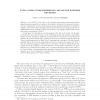Free Online Productivity Tools
i2Speak
i2Symbol
i2OCR
iTex2Img
iWeb2Print
iWeb2Shot
i2Type
iPdf2Split
iPdf2Merge
i2Bopomofo
i2Arabic
i2Style
i2Image
i2PDF
iLatex2Rtf
Sci2ools
ASIACRYPT
2015
Springer
2015
Springer
Type 2 Structure-Preserving Signature Schemes Revisited
At CRYPTO 2014, Abe et al. presented generic-signer structure-preserving signature schemes using Type 2 pairings. According to the authors, the proposed constructions are optimal with only two group elements in each signature and just one verification equation. The schemes beat the known lower bounds in the Type 3 setting and thereby establish that the Type 2 setting permits construction of cryptographic schemes with unique properties not achievable in Type 3. In this paper we undertake a concrete analysis of the Abe et al. claims. By properly accounting for the actual structure of the underlying groups and subgroup membership testing of group elements in signatures, we show that the schemes are not as efficient as claimed. We present natural Type 3 analogues of the Type 2 schemes, and show that the Type 3 schemes are superior to their Type 2 counterparts in every aspect. We also formally establish that in the concrete mathematical structure of asymmetric pairing, all Type 2 structure...
Related Content
| Added | 16 Apr 2016 |
| Updated | 16 Apr 2016 |
| Type | Journal |
| Year | 2015 |
| Where | ASIACRYPT |
| Authors | Sanjit Chatterjee, Alfred Menezes |
Comments (0)

